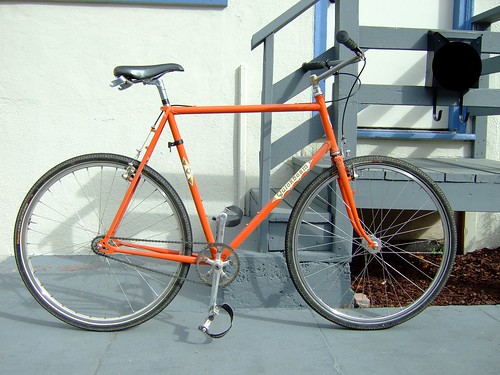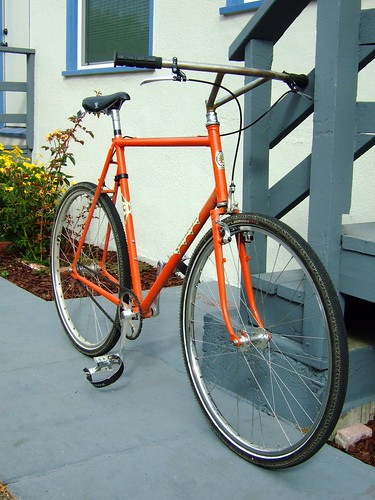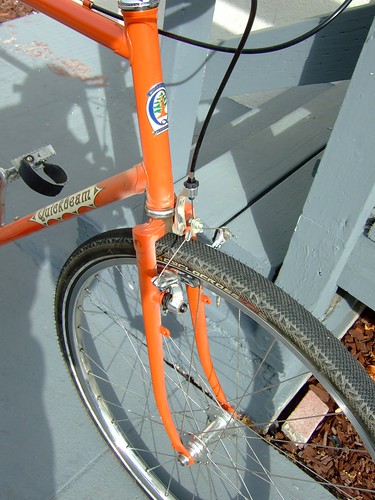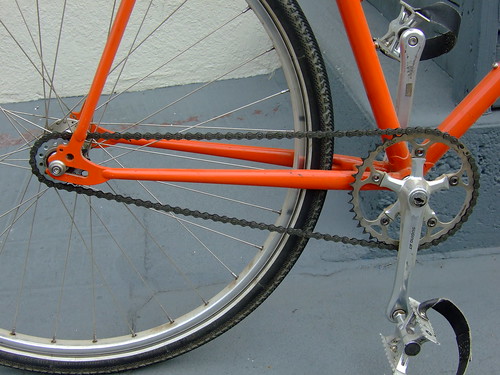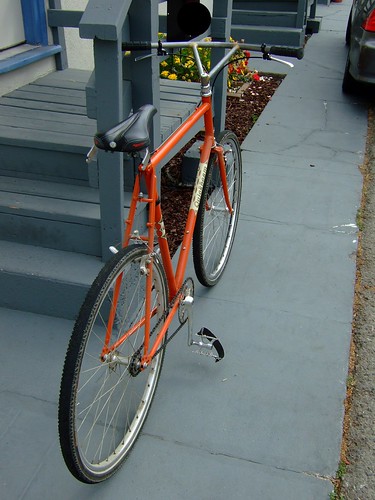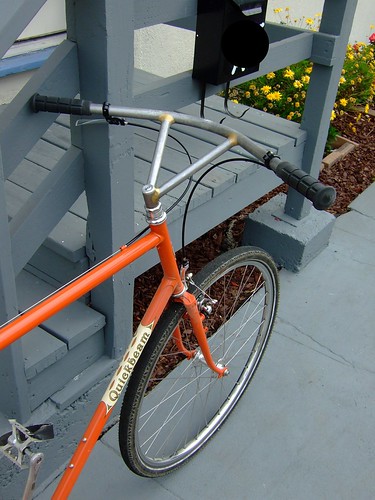As an introduction for this post, I'm going to use a couple of articles from what might be
considered different worlds, but that are dealing with very similar issues in
my book:
Both of these guys, in their own way, aren't struggling with the bleeding
edge of the envelope. It's also not a question of usefulness: both would
probably have separate (albeit related) ideas of what a vehicle needs to be
useful as an everyday mode of transportation. Instead, they're struggling with the question
of building a vehicle (car or bicycle) that fits the need of a person that
heads out on his or her bicycle or in his or her car to have some. Instead of asking about the calculus of speed
or the calculus of everyday usefulness, they're both attempting to develop a
calculus of fun.
In May's case, it's pretty straightforward: acceleration and cornering are
fun. But not acceleration from a standstill up to 200 mph (i.e., not a drag
race), but acceleration on the road, out of a tight corner or passing slower
moving traffic--acceleration from 30-60mph. So: a lightweight car with a
smallish engine that loves to rev. I'm inclined to agree: my lightweight Honda,
on a mountain road, is enormous fun with it's 4-cyl, 127hp engine, especially
if you keep the revs high enough that the variable valve timing is working. My
friend's Toyota MR-2, which in my mind is pretty close to what May is talking
about, is even more fun in the same situation. Any more power, speed, and
attendant bulk would likely exponentially increase the amount of terror, and
not necessarily increase the fun. Keep things small, simple, and zippy. Done.
With Heine, however, the calculus of fun in bicycles is a bit harder to
articulate, it seems like. Unlike May, he doesn't (necessarily) start out by
articulating specific behaviors that are fun (like acceleration and cornering).
He mentions the ability of the frame to help the rider "generate more
power with less fatigue." In my mind, the ability to produce power without
fatigue is mostly about fit: properly arranging bars, seat, and pedals such
that the body is in a comfortable position to use its legs, pelvis, and lower
back to lay down some watts, and at the same time be comfortable enough to ride
for a while without pain. However, fit isn't everything. Heine also discusses
how frames materials should be carefully selected to match the rider and their
pedaling, to create a frame that feels "lively" and "eager to
go" under the rider. However, we don't necessarily get a specific sense of
what "liveliness" is. And this, in think, is where we run into the
limits of cycling terminology and the ability to describe the bicycling
behaviors that we find "fun."
What is “fun” when in comes
to bicycles?
Of course, that’s almost a
too-broad question to ask, dependent entirely on the type of riding you’re
doing. If you need to haul heavy load of
groceries or a drill press, a cargo bike is going to be enormous amounts of
fun, but probably not so fun if you’re trying to ride techy singletrack with
lots of rocks, roots, and whoop-de-doos.
Unless, of course, you get a kick out of riding with the “wrong” bike
for the job, which is entirely valid as well.
But the point is, I’m willing to admit that for some riders, a bike is
fun because it does exactly what they need it to do and nothing more: it
carries what they want/need to carry, it keeps relatively dry and comfortable,
it soaks up the bumps pretty well, and maybe it lights up the road ahead when
it gets dark. Lord knows, finding a bike
that will do all of these things capably is hard enough, and if you are lucky
enough to have one, you can well appreciate the enjoyment of riding it. Indeed, much of Heine’s writing is focused on
exactly these elements of bicycle design, because they are the elements
required by his preferred type of riding (long distance randonneuring), and
after his short discussion of liveliness he spends the rest of the article
talking about tire and fender clearances.
But, let’s narrow it down to
a particular type of riding, say recreational road riding on hilly terrain on
rides from 1-5hrs. Not competitive
racing, nor timed brevet events.
Basically, the vast majority if my own recreational riding, riding just
to get out for a few hours, enjoy yourself, and stay reasonably fit. And, since I don’t really want to talk about
wheels, I’ll just say that let’s assume the frame has appropriate clearances
and brakes for whatever type of wheels you find appropriate to that riding (in
my case, it’s light-ish road wheels with alloy rims, 32 spokes, and light-ish
tires in the 28-38mm range). What other
qualities can we instill in a bicycle frame and components to make the riding
more fun and rewarding?
Some might say, once you’ve
nailed the appropriate wheels and other components, your 90% there, not much
more to talk about. But I would
disagree. My Takara and my Quickbeam are
set up close enough, but the Takara, with is straight gauge, standard-diameter,
4130 frame is a complete, energy sucking dog compared to the nice, “lively”
feel of the Quickbeam with its double butted, oversized, nicer-steel
(Ishiwata?) tubing. I’ve ridden road
bikes that are definitely more responsive than my Casseroll. What makes them better?
One simple answer, which has
dominated the bicycle industry for the last 25+ years, is “stiffness.” It goes like this: some of the energy of
pedaling a bicycle frame goes into flexing the frame, not rotating the
wheels. The less energy we can lose in
flexing the frame, the more energy will be transferred directly to the wheels,
the faster the bicycle will respond to pedaling input and accelerate. So, steel frames went from standard-diameter
to oversize, resulting in stiffer tubes (all other things being equal). Oversize, thin wall aluminum tubing (joined
by TIG welding) became popular. But, as
anybody who rode an early 1990’s Cannondale will tell you, things also got less
comfortable out on the road. So, along
comes carbon fiber. The ability to mold
material by hand, free of the difficulties of forging and welding, allows us to
put material exactly where it’s needed.
We’re able to make bikes that are super-stiff in the drivetrain while
absorbing more shock than the super-stiff bikes of old. They can accelerate with the best of them
while still being comfortable to ride over real-world, potholed roads. And indeed, maximizing stiffness while
retaining comfort seems to have become the only criteria by which bikes are
evaluated in the mainstream cycling media.
Each new model of bike, as a matter of course, has to be stiffer than
its predecessor by some quantifiable degree.
And the hardest part of being a bike reviewer, it seems, is figuring out
new ways to say that now hackneyed phrase: “Laterally stiff and vertically
compliant.”
But is acceleration—and its
related frame quality, stiffness—what it comes down to in the calculus of fun,
as it is for cars? I’m not so sure. And judging by the resurgence in popularity
of steel frames among recreational riders, lead by figures such as Heine and
Grant Peterson of Rivendell, it seems like others might feel the same way. Heine, for one, has been one of the most
outspoken advocates against frame stiffness, saying that his experience and
testing have shown that more flexible frames will feel and respond the best for
some (all?) riders, an effect he ascribes to the elastic qualities of frame
tubing and its ability to flex “in synch” with the pedaling of the rider and
describes as “planing,” a term borrowed from sailing. This is perhaps his most controversial
viewpoint, and it seems difficult to pin down the exact calculus of it. He advocates for more flexible bikes through
the usage of non-oversize, lightweight steel tubing, but hasn’t said much about
how a framebuilder can tune these characteristics to particular riders and
riding styles. Is a large (200lbs+) rider
going to benefit from the same lightweight tubes, or might some riders
experience “planing” even with oversize tubing?
Furthermore, it’s hard to say, but it sounds like Heine basically also
believes that acceleration is the overall calculus here, but that it can be
arrived at in a much different way than the “stiffness” obsession of mainstream
bicycle manufacturers.
Acceleration is certainly
important, and if you like track racing, road sprinting, BMX, etc., it is an
important thing to optimize for. For my
type of road riding, however, I’m not so sure about the whole acceleration
thing. Certainly, it can be nice to feel
a bike squirt forward when you shift up and go for the top of the hill or the
town line sign. But it’s also been my
experience that such bikes lose momentum just as quickly as they gain it, which
can be more fatiguing as you try to find a rhythm on a climb. This also may come down to riding style,
again: I’m a big guy, much more of a Jan Ulrich in my climbing style than an
Alberto Contador. But I think for me,
for a bike to feel “fun,” it should not only get up to speed reasonably
quickly, but balance that with the ability to carry momentum, be it up hills,
around corners, or over potholes.
Personally, I like a bike
that responds well to my pedaling inputs—that gets to speed fairly
quickly—while at the same time, not losing momentum through the “dead” spots in
pedaling input or over potholes. Of
course, this has a lot to do with wheel size and gearing, the cadence at which
you climb. For people who climb with
much faster cadences, the dead spot is only a fraction of a second, so any lost
momentum there is minimal. However, if
you’re like me and diesel away up climbs, you may find that losing momentum
through the dead spot is pretty annoying, as your speed starts to resemble a
sin wave. So, I’m of the opinion that
there is something to steel frames that, aside from just having more mass and
thus more momentum, have some drivetrain “springiness” to them, giving back
some energy as you let off the pedal force slightly through the “dead
spots.” Conversely, it makes sense to
think about how gearing can be matched to frame characteristics. My Salsa Casseroll doesn’t have a lot of the
type of springiness that gives something back through the dead spot, so I’ve
taken climbing in a lower gear with a higher cadence, and have even considering
going to a mountain cassette in the back, although the current 8spd Campagnolo
wheelset (hey, it was cheap at a bike swap) doesn’t provide a lot of choice
when it comes to cassette compatibility.
Thinking about flexiness
brings me to another idea about fun frames: perceived durability. For a frame really to be fun, it has to feel like whatever abuse we’re dishing
out at it, be it rough or dirt roads, heavy braking, or out of the saddle
pedaling, is well within the margin of error for what the frame (and
components) can handle. If I feel like
my bike can’t take my pedaling power or the shock of rolling over broken
pavement at 40mph carrying my mass, I’m going to back off a little, and that’s
not really fun. And I think this is the
feeling that most people associate with “stiffness”: the ability for a bicycle
frame to feel like it can carry them without worrying about it breaking. So while flexiness may feel good to people
like Jan Heine, I’m willing to bet that others are disconcerted by their bottom
bracket swaying about when they get out of the saddle to give it the
beans. It can also lead to other
problems—such as derailleur rub and ghost shifting—which, while not necessarily
safety issues, definitely don’t instill confidence in the rider. Furthermore, while I think overall, lighter
weight bicycles are good thing, there is a limit for me. No matter how many
videos you show me of people banging carbon fiber frames with hammers to show
their durability, I’m just not going to trust a 15lb carbon bike as much as a
25lb steel bike over rough roads or down the occasional single track that I
like to take my road bike.
I say “perceived” because I
think most contemporary bicycles are built by liability-minded manufacturers
that build a pretty big margin of error into most of the products they sell,
and most bicycle frames out there can take a fair amount of abuse above and
beyond their intended purpose without breaking.
Furthermore, it is obvious that people’s perceptions vary: Jan Heine
isn’t as concerned about BB flex as Jan Ulrich might be. So while it may not actually be a problem in
terms of real durability, perceived durability is something we all experience
while riding, and so it can be an important thing to think about while thinking
about how you want a frame to behave and feel.
Of course, with enough work and critical reflection, we can also start
to change our subconscious perceptions, but people may find this more or less
difficult than being aware of what they like to perceive and seeking out those
characteristics.
So looking back, and
comparing calculus of fun when it comes to bicycles to that of cars, we see
that things are bit more complicated in our world than they are for Mr.
May. Stiffness and acceleration can be
good, but so can some springiness and the ability to carry momentum. Lightweight is good, but so is some bulk that
helps you have confidence in your bicycle.
As I’ve written, it’s also become clear some of the behaviors that I
might start to associate with fun, in the same way that mid-range acceleration
and cornering are fun for James May.
Those behaviors are: climbing; getting out of the saddle for efforts;
riding at speed over rough (aka real-world) roads, with the occasional foray
away from pavement. But there’s still a
lot to discuss. How do we design frames,
wheels, and components together thinking about these variables? What about handling, and its relationship to
fit?
As the “towards” in this
title suggests, I didn’t intend to have a fully-fleshed out theory in this
post, but simply to lay out some ideas I had and start a discussion; hopefully
we can add to this and flesh out the theory more going forward. So, dear readers, what do you think? What are the variables in your “calculus of
fun?”
